The Science of GFP Bunny
I've worked with Smart Pop Books on two anthology projects:
Through The Wardrobe (reissued for 2010!)

The World of the Golden Compass

And I'm contributing to this upcoming anthology on The Hunger Games--
The Girl Who Was on Fire: Your Favorite Authors on Suzanne Collins' Hunger Games Trilogy (April 2011)
-- but unfortunately I missed out contributing to The Science of Michael Crichton --
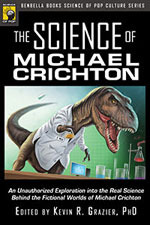
--because I am not a scientist nor have I written about science in any substantive way -- although stay tuned.
The Science of Michael Crichton is great because it led me to GFP Bunny:

GFP Bunny is a transgenic animal art project created by Eduardo Kac (pronounced "Katz") in 2000. Its genome was modified to result in cells that produce florescence when excited by light of a certain wavelength, in this case blue light with maximum excitation occurring at wavelengths of 488 nm. Exposure to this light causes GFP Bunny, who Kac named "Alba", to glow green light at 509 nm. In normal light, she looks like this:
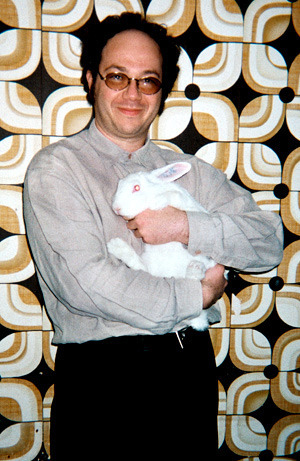
The essay that mentions GFP Bunny, by freelance writer and former associate biochemistry professor Phill Jones, covers Crichton's Next (2006):
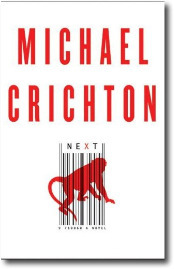
Next was the last album Crichton published before he died. He had really learned how to name his characters by this point:
Alex Burnet (heroine, who may or may not be brunette, I forget, which is great for casting)
Frank Burnet (Alex's father, who gets his genes stolen)
Michael Gross (the doctor who steals Alex's father genes)
Vasco Borden (the bounty hunter who tracks down Alex's father's genes in Alex's body)
"Jack" Watson (ruthless venture capitalist)
Brad Gordon (irresponsible nephew)
Mick Crowley (allegedly based on Michael Crowley)
Dave (talking chimp boy)
Crichton also knew how to name the science:
LoxP
Cre recombinase
lentiviral vectors
homologous recombination
cytokines
Given those scientific terms and those characters, how could you not write a novel with an intelligent parrot? Of course we're far away from people branding sea turtles with corporate logos but that's why they call it speculative fiction. Both Jones' essay and Dave Itzkoff's New York Times review quote Michael Crichton's message to the readers:
"This novel is fiction, except for the parts that aren't."
Which brings me back to the bunny. Because although GFP Bunny has been vetted by reputable news organizations, I remember Photoshop being pretty good back in 2000, and I see a striking resemblance between the tonal hues of Eduardo Kac's project and High on Fire's 2000 album The Art of Self-Defense:
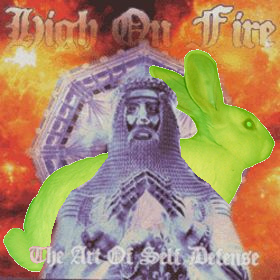
In Other News
Congratulations to all winners of the Its Kind of a Funny Story Movie Stub/Book Giveaway Contest! Our winners came from all over the United States:
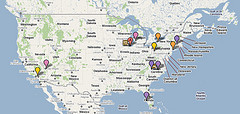
Photos of ticket stubs are here: It's Kind of a Funny Story in the Real World. Stay tuned for news of the DVD release!
Through The Wardrobe (reissued for 2010!)

The World of the Golden Compass

And I'm contributing to this upcoming anthology on The Hunger Games--
The Girl Who Was on Fire: Your Favorite Authors on Suzanne Collins' Hunger Games Trilogy (April 2011)
-- but unfortunately I missed out contributing to The Science of Michael Crichton --

--because I am not a scientist nor have I written about science in any substantive way -- although stay tuned.
The Science of Michael Crichton is great because it led me to GFP Bunny:

GFP Bunny is a transgenic animal art project created by Eduardo Kac (pronounced "Katz") in 2000. Its genome was modified to result in cells that produce florescence when excited by light of a certain wavelength, in this case blue light with maximum excitation occurring at wavelengths of 488 nm. Exposure to this light causes GFP Bunny, who Kac named "Alba", to glow green light at 509 nm. In normal light, she looks like this:

The essay that mentions GFP Bunny, by freelance writer and former associate biochemistry professor Phill Jones, covers Crichton's Next (2006):

Next was the last album Crichton published before he died. He had really learned how to name his characters by this point:
Alex Burnet (heroine, who may or may not be brunette, I forget, which is great for casting)
Frank Burnet (Alex's father, who gets his genes stolen)
Michael Gross (the doctor who steals Alex's father genes)
Vasco Borden (the bounty hunter who tracks down Alex's father's genes in Alex's body)
"Jack" Watson (ruthless venture capitalist)
Brad Gordon (irresponsible nephew)
Mick Crowley (allegedly based on Michael Crowley)
Dave (talking chimp boy)
Crichton also knew how to name the science:
LoxP
Cre recombinase
lentiviral vectors
homologous recombination
cytokines
Given those scientific terms and those characters, how could you not write a novel with an intelligent parrot? Of course we're far away from people branding sea turtles with corporate logos but that's why they call it speculative fiction. Both Jones' essay and Dave Itzkoff's New York Times review quote Michael Crichton's message to the readers:
"This novel is fiction, except for the parts that aren't."
Which brings me back to the bunny. Because although GFP Bunny has been vetted by reputable news organizations, I remember Photoshop being pretty good back in 2000, and I see a striking resemblance between the tonal hues of Eduardo Kac's project and High on Fire's 2000 album The Art of Self-Defense:

In Other News
Congratulations to all winners of the Its Kind of a Funny Story Movie Stub/Book Giveaway Contest! Our winners came from all over the United States:

Photos of ticket stubs are here: It's Kind of a Funny Story in the Real World. Stay tuned for news of the DVD release!
Published on December 04, 2010 17:48
No comments have been added yet.
Ned Vizzini's Blog
- Ned Vizzini's profile
- 3009 followers
Ned Vizzini isn't a Goodreads Author
(yet),
but they
do have a blog,
so here are some recent posts imported from
their feed.



